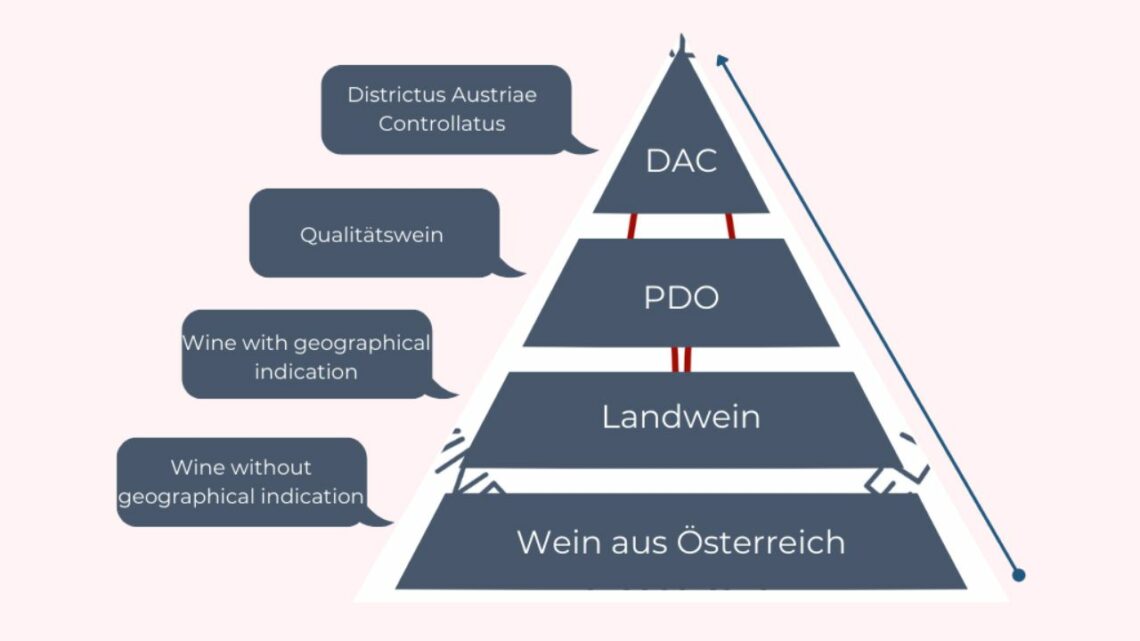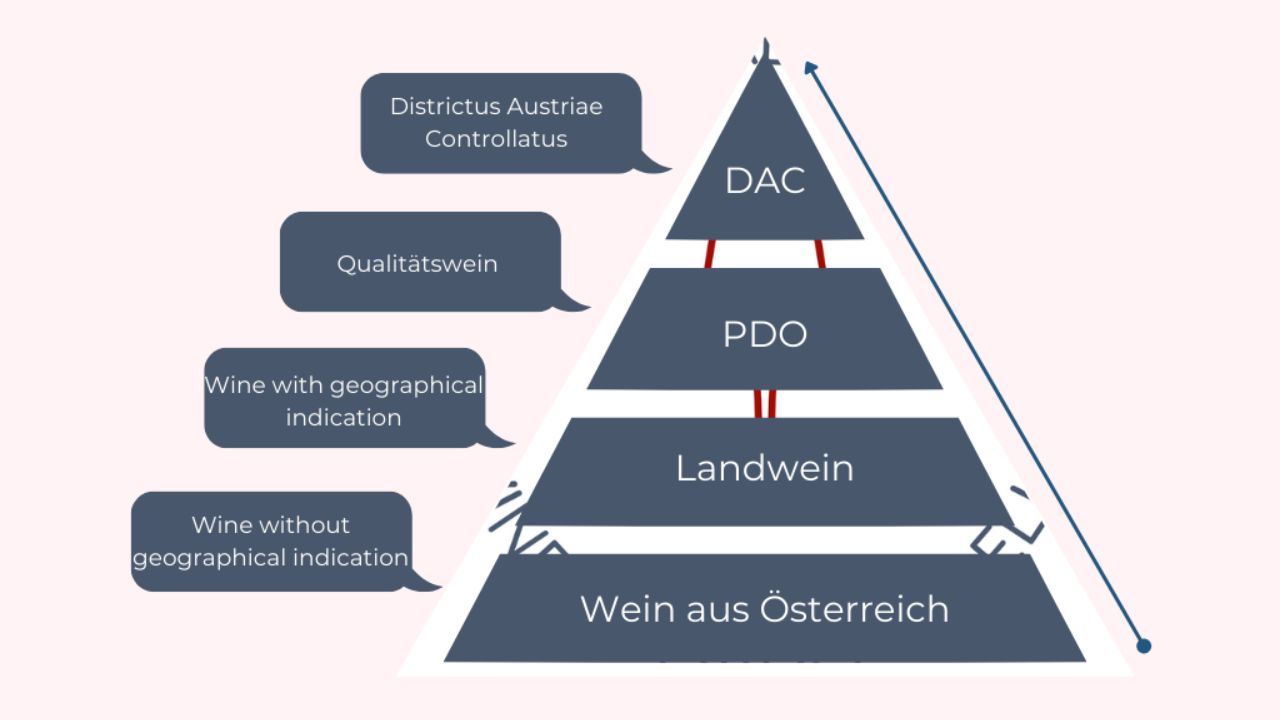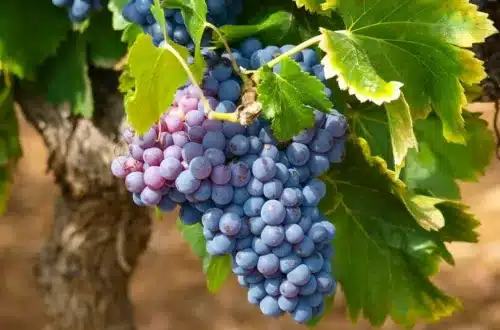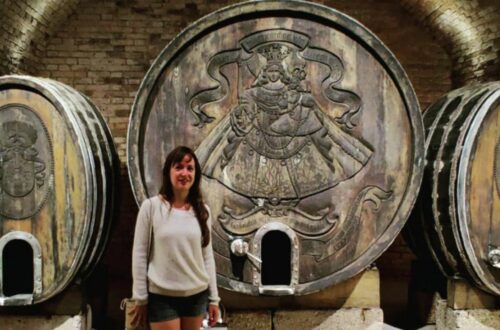
What are the major quality levels of Austrian wine?
A very important characteristic (although not the only one) for distinguishing various levels of quality is the natural sugar content of grapes at harvest. This natural sugar content is referred to as the ‘must density’ of grapes or unfermented must.
DEFINITION : The terms “grape must” and “partially fermented grape must (or Sturm)” are defined by European Union legislation and specified by national provisions. Grape must obtained exclusively from grapes harvested and processed in Austria may be marketed for direct human consumption between August 1st and December 31st of the harvest year under the designation “Austrian grape must.”
In Austria, the must density is indicated in Klosterneuburg must degrees (‘degrees Klosterneuburger Mostwaage’ – °KMW). In Germany, it is indicated in Öchsle degrees. Internationally, the term ‘potential alcohol content’ is also commonly used (how much alcohol can be obtained through the complete fermentation of the naturally present sugar?).
For wines, Landwein, and simple Qualitätswein (excluding quality wines of the Kabinett or Prädikatswein types), the natural sugar content of the must can be supplemented by the addition of beet sugar (sucrose) or concentrated grape must or rectified concentrated grape must. This process is referred to as ‘enrichment’ or ‘must chaptalization’. In Austria, the upper limit for enrichment is 2% vol.
The competent authorities for the control of all wines are the Federal Viticulture Inspection, the Federal Office of Viticulture in Eisenstadt, the Federal Higher College, and the Federal Office of Viticulture and Arboriculture in Klosterneuburg.
ANECDOTE : The Klosterneuburg mustimeter was developed in 1896 by Baron de Babo (at that time Director of the Klosterneuburg Viticulture School) for determining the sugar content of grapes. The KMW value indicates the sugar content in weight percentage. In other words, 1°KMW = 1% sugar. Simplified conversion to Öchsle degrees: 1°KMW corresponds to approximately 5°Öchsle. The conversion formula is as follows: (0,022 x °KMW + 4,54) x °KMW = Öchsle
SUMMARY : In Austrian wine production, there are three categories of wine: wine without geographical indication, wine with geographical indication, and protected designation of origin (PDO) wine. Wine without geographical indication is labeled as “Wein” or “Wein aus Österreich” for still wines and “Österreicher Sekt” for sparkling wines.
These wines have specific requirements for must density and alcohol content, and certain designations like “Bergwein” and “Heuriger” are allowed. Wine with geographical indication is known as “Landwein” and comes from specific wine regions with defined must density and alcohol content requirements.
PDO wine is called “Qualitätswein” and is subject to state control. It must be produced from grapes harvested in the same wine-growing region, meet specific criteria regarding grape varieties and must density, and possess the typical properties of the designation. Within the PDO wine category, there are further quality levels such as Kabinettwine and DAC.
Additionally, Austrian wine includes various special classifications like Ausbruch, Trockenbeerenauslese, and Sekt g.U., each with its own production and quality requirements. These classifications ensure the authenticity and quality of Austrian wines, providing consumers with clear distinctions and designations to make informed choices.
3 categories of wine
Wine without geographical indication
These wines are either labeled “Wein” (or “Wein aus Österreich”) for still wines and “Österreicher Sekt” for sparkling wines.
Regarding still wines, the must density is a minimum of 10.7°KMW (51°Ö) and the alcohol content is 8.5% vol. The designations “Bergwein” (mountain wine, originating from vineyards with slopes of more than 26% gradient) and “Heuriger” (bottled, with vintage indication) are allowed.
ANECDOTE : Indeed, in Austria, vintage and grape variety designations are only allowed if the maximum yield per hectare for Landwein and Qualitätswein is respected.
“Österreichischer Sekt” (“Österreichischer Qualitätsschaumwein”) – meaning Austrian sparkling wine or quality sparkling wine – without geographical indication or protected designation of origin can only be marketed under this designation if it exclusively comes from the 40 authorized grape varieties for the production of Qualitätswein in Austria and is impeccable in terms of appearance, aroma, and taste.
The products “Österreichischer Sekt” and “Sekt g.U.” must exhibit – in sealed containers at a temperature of 20°C – a minimum over pressure of 3.5 bar due to the presence of dissolved carbon dioxide.
If either the grapes used for production or the base wine are sourced from Austria, the product can bear the designation “Österreichischer Sekt.” If only the production of Sekt took place in Austria, the product can bear the designation “produziert in Österreich” (produced in Austria).
Wine with geographical indication
In Austrian wine legislation, the traditional term “Landwein” replaces the marketing denomination of the European regulation “Wine with Protected Indication.” Indicating a smaller geographical entity than the wine region, as well as any marketing denomination other than “Landwein,” is prohibited.
The grape juice has a must density of at least 14°KMW, and the alcohol content is a minimum of 8.5% vol.
The grapes intended for the production of “Landwein” country wine come from the wine regions of Weinland, Steirerland, or Bergland.
Protected designation of origin wine (PDO Wine)
The term “Qualitätswein” is a traditional Austrian term that replaces the marketing designation of the European regulation “Wein g.U.” for wines with protected designation of origin. The grapes for Qualitätswein come from specific wine-growing regions. The indication of the commercial designation “Wein mit geschützter Ursprungsbezeichnung” or “Wein g.U.” is allowed. It is identified by a red-white-red banderole with the producer’s identification number on the bottleneck
Qualitätswein can only be sold to consumers domestically and abroad if it has undergone state control. The state control number must be indicated on the label.
The wine can be marketed under the designation “Qualitätswein” if, among other criteria:
- It was produced exclusively from grapes harvested in the same wine-growing region, and the production took place either in the corresponding wine region or in a neighboring wine region.
- It was produced exclusively from grape varieties approved for Qualitätswein.
- The grape juice had a must density of at least 15 °KMW.
- It possesses the typical properties corresponding to the designation and has met the minimum requirements during sensory evaluation at the time of state control number allocation.
- The measured alcohol content is at least 9.0% vol., and at least 5.0% vol. for quality wines of the “Prädikatswein” type.
The major quality levels of Austrian wine
Kabinettwein
Qualitätswein can be marketed under the designation “Kabinett” or “Kabinettwein” if:
- The grape juice had a must density of at least 17 °KMW.
- It has not undergone any enrichment.
- The unfermented sugar content is a maximum of 9 g/l.
- The total alcohol content is a maximum of 12.9% vol.
- It has not undergone any sweetening.
DAC
Qualitätswein can be marketed under the designation “Districtus Austriae Controllatus” or “DAC” if it also meets the conditions defined by the National Committee upon the Minister of Agriculture’s order for typical Qualitätswein with origin profiles.
The designation “Districtus Austriae Controllatus” or “DAC” must be indicated in combination with the respective defined area according to the ordinance. This geographical indication can only be used in combination with the designation “Districtus Austriae Controllatus” or “DAC” and under the corresponding conditions.
The use of a smaller geographical entity name than the wine region is allowed.
For many wines with protected designation of origin, the trend is moving towards a clear distinction between three variations: Gebietswein (regional PDO wine), Ortswein (municipal PDO wine), and Riedenwein (single vineyard wine).
If you want to know more about DAC in Austria, I’ve written a whole post about it!
Prädikatswein
In Austria, “Prädikatswein” wines are part of the Qualitätswein category. They are Qualitätswein of special maturity and harvest, which can be designated with either generic origins (e.g., “Burgenland”) or specific origins (e.g., “Wagram”), as long as the specific area does not yet have DAC status for other styles of wines.
The system of “Prädikatswein” wines, which involves multiple differentiations of wines with naturally high sugar content achieved through special ripening and harvesting methods, is a specific feature of German and Austrian regulations regarding the production and marketing of wines.
To declare a wine as “Prädikatswein,” it must meet the criteria below and also have a confirmation of the quality of the harvested grapes (the “must weight confirmation”) issued by the Wine Control Office. The grape must should not undergo enrichment. The residual sugar should only be obtained through the early interruption of fermentation and not by adding grape must to the wine.
Within the Prädikatswein system, several levels are defined, each with its specific criteria. The Spätlese corresponds to fully matured grapes, with a must density of at least 19 °KMW (94.2 °Ö). Wines of this level cannot be submitted for state control approval before January 1st of the following year’s harvest.
The Auslese, on the other hand, is made from sorted grapes, where only fully ripe ones are selected, eliminating immature, defective, or diseased berries. The must density must be at least 21 °KMW (105 °Ö), and the wines cannot be submitted for state control approval before January 1st of the following year’s harvest.
The Beerenauslese is produced from overripe grapes affected by noble rot. The must density must reach a minimum of 25 °KMW (127.3 °Ö), and the wines cannot be submitted for state control approval before April 1st of the following year’s harvest.
The Eiswein, also known as ice wine, is made from grapes that were frozen during harvesting and pressing. The must density must be at least 25 °KMW (127.3 °Ö), and the wines cannot be submitted for state control approval before April 1st of the following year’s harvest.
The Strohwein/Schilfwein, or straw wine, is produced from fully matured and sugar-rich grape clusters that have been stored for at least three months on straw, reeds, or hung on strings before vinification. The must density must be at least 25 °KMW (127.3 °Ö), and the wines cannot be submitted for state control approval before April 1st of the following year’s harvest.
Ausbruch is a unique classification in Austrian winemaking, characterized by its specific winemaking process. With a minimum must density of 27 KMW, Ausbruch allows the addition of freshly made juice or wine of at least Spätlese quality during the fermentation stage.
Finally, the Trockenbeerenauslese is a wine primarily made from botrytized and withered berries. The must density must reach a minimum of 30 °KMW (156 °Ö), and the wines cannot be submitted for state control approval before April 1st of the following year’s harvest.
Sekt g.U
In principle, the regulation stipulates that Austrian sparkling wine with a protected designation of origin, “Österreichischer Sekt mit geschützter Ursprungsbezeichnung” (“Sekt g.U.”), can only be marketed under the designations “Klassik,” “Reserve,” or “Große Reserve,” according to the conditions defined in the corresponding ordinance.
The commercial designation must include the category (quality sparkling wine or Sekt), the name of the protected designation of origin (administrative region and, if applicable, municipality/part of the municipality), and the indications “geschützte Ursprungsbezeichnung” or “g.U.” (protected designation of origin). The additional mention “Hauersekt” can be added as well.
Within the Sekt g.U. classification, specific conditions must be met for the commercial designations of “Sekt g.U. Klassik,” “Sekt g.U. Reserve,” and “Sekt g.U. Große Reserve.”
For “Sekt g.U. Klassik,” the prerequisites include harvesting the base grapes within a single administrative region, a minimum 9-month aging on lees regardless of the production method, consumer sales starting no earlier than October 22nd (Austrian Sparkling Wine Day) of the year following the harvest, a maximum alcoholic strength of 12.5% vol. indicated on the label, and the mandatory indication of the administrative region as the protected designation of origin, without any more specific geographic indication than the administrative region.
As for “Sekt g.U. Reserve“, the requirements are harvesting and pressing (with a maximum yield rate of 60%) the grapes from a single administrative region, mandatory manual harvesting and pressing of whole clusters, at least 18 months of aging on lees, exclusive production using the traditional bottle fermentation method (“Méthode traditionnelle”), consumer sales starting no earlier than October 22nd of the second year following the harvest, a maximum residual sugar content of 12 g/l, and the mandatory indication of the administrative region, with no more detailed geographic indication allowed.
Regarding “Sekt g.U. Große Reserve“, the conditions involve harvesting and pressing (with a maximum yield rate of 50%) the grapes from a single commune, mandatory manual harvesting and pressing of whole clusters, a minimum 30-month aging on lees, exclusive production using the traditional bottle fermentation method, consumer sales starting no earlier than October 22nd of the third year following the harvest, a maximum residual sugar content of 12 g/l, the mandatory indication of the administrative region as the protected designation of origin, and the mandatory indication of a specific commune (or part of a commune), with at least 85% of the grapes originating from that commune.
Additionally, if up to 15% of the grapes come from a neighboring commune, which can be located in a different administrative region or winegrowing area but cultivated by the same winemaker and transported for all post-harvest operations, the designation of that commune or administrative region can also be mentioned.
These conditions ensure the quality and authenticity of Austrian sparkling wines, allowing consumers to make informed choices based on the specific classifications and designations.
Conclusion : What are the major quality levels of Austrian wine?
The major quality levels of Austrian wine are as follows:
- Qualitätswein (Quality Wine): This is the category for wines with protected designation of origin (PDO). Qualitätswein must be produced exclusively from grapes harvested in the same wine-growing region, adhere to specific grape variety requirements, and meet criteria for must density, sensory evaluation, and alcohol content. It undergoes state control and is identified by a red-white-red banderole on the bottleneck.
- Kabinettwine: Qualitätswein can be marketed as Kabinett or Kabinettwein if it meets certain criteria. These include a minimum must density of 17°KMW, no enrichment, a maximum unfermented sugar content of 9 g/l, and a maximum total alcohol content of 12.9% vol.
- DAC (Districtus Austriae Controllatus): Qualitätswein can be marketed as DAC if it meets specific conditions defined by the National Committee upon the Minister of Agriculture’s order. DAC wines have origin profiles that reflect the typical characteristics of their designated region. The DAC designation must be accompanied by the respective defined area according to the ordinance.
- Prädikatswein: Prädikatswein is a special category within Qualitätswein. These are wines of special maturity and harvest, distinguished by their specific sugar content achieved through special ripening and harvesting methods. Prädikatswein can be designated with generic origins (e.g., “Burgenland”) or specific origins (e.g., “Wagram”). The different levels within the Prädikatswein system include Spätlese, Auslese, Beerenauslese, Eiswein, Strohwein/Schilfwein, and Trockenbeerenauslese. Each level has its own criteria regarding must density, grape selection, and production methods.
These quality levels ensure that Austrian wines are classified and labeled according to their specific characteristics, origin, and production.







